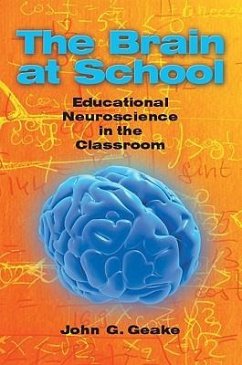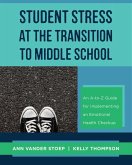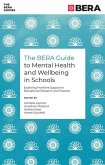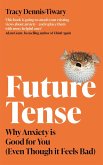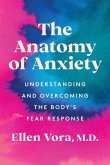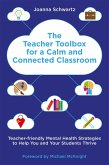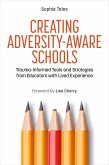John Geake
The Brain at School: Educational Neuroscience in the Classroom
John Geake
The Brain at School: Educational Neuroscience in the Classroom
- Broschiertes Buch
- Merkliste
- Auf die Merkliste
- Bewerten Bewerten
- Teilen
- Produkt teilen
- Produkterinnerung
- Produkterinnerung
This friendly book is jargon-free and no prior scientific knowledge is assumed of the reader. It is thought-provoking reading for practising teachers across all age ranges, trainee teachers, parents, head teachers, educational policymakers, academics and educational psychologists.
Andere Kunden interessierten sich auch für
![Student Stress at the Transition to Middle School: An A-To-Z Guide for Implementing an Emotional Health Check-Up Student Stress at the Transition to Middle School: An A-To-Z Guide for Implementing an Emotional Health Check-Up]() Ann Vander Stoep (University of Washington)Student Stress at the Transition to Middle School: An A-To-Z Guide for Implementing an Emotional Health Check-Up24,99 €
Ann Vander Stoep (University of Washington)Student Stress at the Transition to Middle School: An A-To-Z Guide for Implementing an Emotional Health Check-Up24,99 €![The Bera Guide to Mental Health and Wellbeing in Schools The Bera Guide to Mental Health and Wellbeing in Schools]() Michelle JaymanThe Bera Guide to Mental Health and Wellbeing in Schools38,99 €
Michelle JaymanThe Bera Guide to Mental Health and Wellbeing in Schools38,99 €![Future Tense Future Tense]() Tracy Dennis-TiwaryFuture Tense21,99 €
Tracy Dennis-TiwaryFuture Tense21,99 €![Future Tense Future Tense]() Tracy Dennis-TiwaryFuture Tense33,99 €
Tracy Dennis-TiwaryFuture Tense33,99 €![The Anatomy of Anxiety The Anatomy of Anxiety]() Ellen VoraThe Anatomy of Anxiety38,99 €
Ellen VoraThe Anatomy of Anxiety38,99 €![The Teacher Toolbox for a Calm and Connected Classroom The Teacher Toolbox for a Calm and Connected Classroom]() Joanna SchwartzThe Teacher Toolbox for a Calm and Connected Classroom32,99 €
Joanna SchwartzThe Teacher Toolbox for a Calm and Connected Classroom32,99 €![Creating Adversity-Aware Schools Creating Adversity-Aware Schools]() Sophie TalesCreating Adversity-Aware Schools24,99 €
Sophie TalesCreating Adversity-Aware Schools24,99 €-
-
-
This friendly book is jargon-free and no prior scientific knowledge is assumed of the reader. It is thought-provoking reading for practising teachers across all age ranges, trainee teachers, parents, head teachers, educational policymakers, academics and educational psychologists.
Produktdetails
- Produktdetails
- Verlag: Open University Press
- Seitenzahl: 248
- Erscheinungstermin: August 2009
- Englisch
- Abmessung: 230mm x 151mm x 19mm
- Gewicht: 374g
- ISBN-13: 9780335234219
- ISBN-10: 0335234216
- Artikelnr.: 26217776
- Herstellerkennzeichnung
- Libri GmbH
- Europaallee 1
- 36244 Bad Hersfeld
- gpsr@libri.de
- Verlag: Open University Press
- Seitenzahl: 248
- Erscheinungstermin: August 2009
- Englisch
- Abmessung: 230mm x 151mm x 19mm
- Gewicht: 374g
- ISBN-13: 9780335234219
- ISBN-10: 0335234216
- Artikelnr.: 26217776
- Herstellerkennzeichnung
- Libri GmbH
- Europaallee 1
- 36244 Bad Hersfeld
- gpsr@libri.de
John G. Geake is Professor of Learning and Teaching in the School of Education, The University of New England, Australia. John co-founded the Oxford Cognitive Neuroscience Education Forum and conducted research at the Centre for Functional Magnetic Resonance Imaging of the Brain, Oxford, UK.
INTRODUCTION
A case for educational neuroscience
Caveats and disclaimers
CHAPTER 1: WHY EDUCATIONAL NEUROSCIENCE?
Education neuroscientific research questions
Limits to educational neuroscience
CHAPTER 2: NEUROIMAGING TECHNOLOGIES
CHAPTER 3: LEARNING AND MEMORY
Individual brains
Hebb's model of learning through synaptic plasticity
Memory
CHAPTER 4: WORKING MEMORY AND INTELLIGENCE
Working memory
Attention
Intelligence
Gifted and talented pupils
Sex differences
Genetics of intelligence
IQ scores as a measure of social evolution
CHAPTER 5: CREATIVITY AND IMAGINATION
Fluid analogising
Creative intelligence
Imagination
CHAPTER 6: SOCIALISING, EMOTION AND MOTIVATION
Mirror neurons and socialising
Emotion
Motivation and self-esteem
Attention Deficit Hyperactivity Disorder
CHAPTER 7: LANGUAGE AND LITERACY
Language
Story telling
Literacy
Dyslexia
Second language learning
CHAPTER 8: NUMERACY AND MATHEMATICS
Arithmetic
Statistics
Fractions
Algebra and geometry
Mathematical thinking
Mathematical creativity
CHAPTER 9: ARTS CURRICULUM
Music
Visual arts
CHAPTER 10: A FUTURE FOR EDUCATIONAL NEUROSCIENCE
Schools of the future
An agenda for educational neuroscience
Last word
A case for educational neuroscience
Caveats and disclaimers
CHAPTER 1: WHY EDUCATIONAL NEUROSCIENCE?
Education neuroscientific research questions
Limits to educational neuroscience
CHAPTER 2: NEUROIMAGING TECHNOLOGIES
CHAPTER 3: LEARNING AND MEMORY
Individual brains
Hebb's model of learning through synaptic plasticity
Memory
CHAPTER 4: WORKING MEMORY AND INTELLIGENCE
Working memory
Attention
Intelligence
Gifted and talented pupils
Sex differences
Genetics of intelligence
IQ scores as a measure of social evolution
CHAPTER 5: CREATIVITY AND IMAGINATION
Fluid analogising
Creative intelligence
Imagination
CHAPTER 6: SOCIALISING, EMOTION AND MOTIVATION
Mirror neurons and socialising
Emotion
Motivation and self-esteem
Attention Deficit Hyperactivity Disorder
CHAPTER 7: LANGUAGE AND LITERACY
Language
Story telling
Literacy
Dyslexia
Second language learning
CHAPTER 8: NUMERACY AND MATHEMATICS
Arithmetic
Statistics
Fractions
Algebra and geometry
Mathematical thinking
Mathematical creativity
CHAPTER 9: ARTS CURRICULUM
Music
Visual arts
CHAPTER 10: A FUTURE FOR EDUCATIONAL NEUROSCIENCE
Schools of the future
An agenda for educational neuroscience
Last word
INTRODUCTION
A case for educational neuroscience
Caveats and disclaimers
CHAPTER 1: WHY EDUCATIONAL NEUROSCIENCE?
Education neuroscientific research questions
Limits to educational neuroscience
CHAPTER 2: NEUROIMAGING TECHNOLOGIES
CHAPTER 3: LEARNING AND MEMORY
Individual brains
Hebb's model of learning through synaptic plasticity
Memory
CHAPTER 4: WORKING MEMORY AND INTELLIGENCE
Working memory
Attention
Intelligence
Gifted and talented pupils
Sex differences
Genetics of intelligence
IQ scores as a measure of social evolution
CHAPTER 5: CREATIVITY AND IMAGINATION
Fluid analogising
Creative intelligence
Imagination
CHAPTER 6: SOCIALISING, EMOTION AND MOTIVATION
Mirror neurons and socialising
Emotion
Motivation and self-esteem
Attention Deficit Hyperactivity Disorder
CHAPTER 7: LANGUAGE AND LITERACY
Language
Story telling
Literacy
Dyslexia
Second language learning
CHAPTER 8: NUMERACY AND MATHEMATICS
Arithmetic
Statistics
Fractions
Algebra and geometry
Mathematical thinking
Mathematical creativity
CHAPTER 9: ARTS CURRICULUM
Music
Visual arts
CHAPTER 10: A FUTURE FOR EDUCATIONAL NEUROSCIENCE
Schools of the future
An agenda for educational neuroscience
Last word
A case for educational neuroscience
Caveats and disclaimers
CHAPTER 1: WHY EDUCATIONAL NEUROSCIENCE?
Education neuroscientific research questions
Limits to educational neuroscience
CHAPTER 2: NEUROIMAGING TECHNOLOGIES
CHAPTER 3: LEARNING AND MEMORY
Individual brains
Hebb's model of learning through synaptic plasticity
Memory
CHAPTER 4: WORKING MEMORY AND INTELLIGENCE
Working memory
Attention
Intelligence
Gifted and talented pupils
Sex differences
Genetics of intelligence
IQ scores as a measure of social evolution
CHAPTER 5: CREATIVITY AND IMAGINATION
Fluid analogising
Creative intelligence
Imagination
CHAPTER 6: SOCIALISING, EMOTION AND MOTIVATION
Mirror neurons and socialising
Emotion
Motivation and self-esteem
Attention Deficit Hyperactivity Disorder
CHAPTER 7: LANGUAGE AND LITERACY
Language
Story telling
Literacy
Dyslexia
Second language learning
CHAPTER 8: NUMERACY AND MATHEMATICS
Arithmetic
Statistics
Fractions
Algebra and geometry
Mathematical thinking
Mathematical creativity
CHAPTER 9: ARTS CURRICULUM
Music
Visual arts
CHAPTER 10: A FUTURE FOR EDUCATIONAL NEUROSCIENCE
Schools of the future
An agenda for educational neuroscience
Last word

